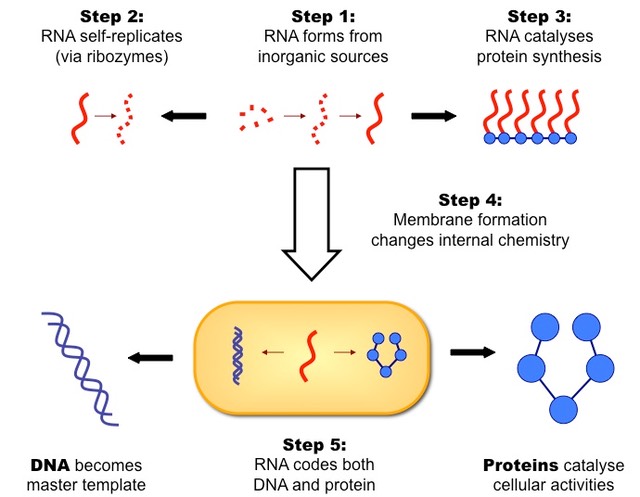D.1.1 Describe four processes needed for the spontaneous origin of life on Earth
1. The non-living synthesis of simple organic molecules (from primordial inorganic compounds)
2. The assembly of these organic molecules into polymers
3. The formation of polymers that can self-replicate (enabling inheritance)
4. Packaging of these molecules into membranes with an internal chemistry different from their surroundings
D.1.2 Outline the experiments of Miller and Urey into the origin of organic compounds
Miller and Urey recreated the conditions of pre-biotic Earth in a closed system consisting of a series of flasks and tubes
- These conditions included a reducing atmosphere (low oxygen), high radiation levels, high temperatures and electrical storms
- Water was boiled to form vapour and then was mixed with methane, ammonia and hydrogen
- The mixture of gases was exposed to an electrical discharge (sparks) to simulate lightning
- The mixture was then allowed to cool and after one week was found to contain some simple amino acids and complex oily hydrocarbons
- Based on these findings, it was concluded that under the hypothesised conditions of pre-biotic Earth, organic molecules could be formed
The Miller-Urey Experiment

D.1.3 State that comets may have delivered organic compounds to Earth
Comets contain a variety of organic molecules (~20% of a comet's tail is comprised of organic material)
Heavy bombardment about 4,000 million years ago may have delivered both organic compounds and water to early Earth
D.1.4 Discuss possible locations where conditions would have allowed for the synthesis of organic compounds
Organic synthesis requires the presence of a range of inorganic molecules and an energy source to combine them into organic forms
Locations where such conditions may have existed in the past include:
- Hydrothermal vents: Regions of the ocean floor where superheated water is released from the Earth's crust
- Volcanoes: Intensive volcanic activity could provide sufficient thermal activity either on land or under the seabed
- Extraterrestrial locations: Other planets (e.g. Mars) may have been subjected to appropriate conditions (compound transfer via meteorites)
D.1.5 Outline two properties of RNA that would have allowed it to play a role in the origin of life
The RNA world hypothesis proposes that a world filled with RNA-based life predates current DNA-based organisms
RNA has two key properties that would have allowed it to function in this manner:
1. RNA can self-replicate
- RNA is able to store information in a sequence of four nucleotides (similar to DNA)
- Short sequences of RNA have been able to duplicate other molecules of RNA accurately
2. RNA can act as a catalyst
- Modern cells use RNA catalysts (called ribozymes) to remove introns from mRNA and help synthesise new RNA molecules
- In ribosomes, rRNA is found in the catalytic site and plays a role in peptide bond formation
RNA is the only molecule capable of both these properties but has since been superceded:
- DNA, through its greater chemical stability (double helical structure) has taken over as the data storage form
- Protein, through its greater variability (20 amino acids as opposed to 4 nucleotides) has taken over as the catalytic form
The RNA World Hypothesis

D.1.6 State that living cells may have been preceded by protobionts, with an internal chemical environment different to their surroundings
Protobionts are aggregates of abiotically produced organic molecules surrounded by a membrane or membrane-like structure
Examples include coacervates and microspheres
A membrane creates an internal chemical environment different to the surroundings, which could lead to optimal conditions for life activities
D.1.7 Outline the contribution of prokaryotes to the creation of an oxygen-rich atmosphere
Primordial Earth had a reducing atmosphere that contained very low levels of oxygen gas
After about ~2 billion years of prokaryotic life, a form of chlorophyll evolved in prokaryotes (forming cyanobacteria)
This allowed for the process of photosynthesis to occur, creating oxygen gas as a by-product via the photolysis of water
The increase in oxygen in the atmosphere lead to:
- The breakdown of chemicals in the atmosphere and oceans to produce oxidised compounds (e.g. CO2)
- The evolution of organisms capable of breaking down oxygen-rich oxidising agents
- The formation of an ozone layer which restricted UV radiation to allow for the proliferation of a wider range of life forms
D.1.8 Discuss the endosymbiotic theory for the origin of eukaryotes
An endosymbiont is a cell which lives inside another cell with mutual benefit
Eukaryotic cells are believed to have evolved from aerobic prokaryotes that were engulfed by endocytosis
Mitochondria and chloroplasts are suggested to have originated by endosymbiosis

Evidence supporting the theory of endosymbiosis:
- Mitochondria and chloroplasts have their own DNA (which is naked and circular)
- Mitochondria and chloroplasts have ribosomes that are similar to prokaryotes (70S)
- Mitochondria and chloroplasts have a double membrane and the inner membrane has proteins similar to prokaryotes
- Mitochondria and chloroplasts are roughly the same size as bacteria and are susceptible to the antibiotic chloramphenicol